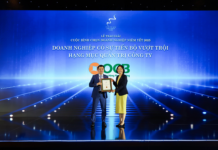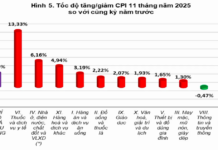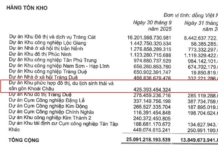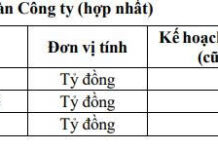Green Growth and Sustainable Development: A Global Trend
Green growth and sustainable development are inevitable trends that every country aspires to, including Vietnam, which faces significant environmental challenges and is heavily affected by climate change. However, as of early 2024, green credit debt is estimated to reach VND 500 trillion, accounting for only about 4.5% of total bank credit debt. This number falls short of expectations.

Production line at OPC Pharmaceutical Joint Stock Company – a green enterprise in Tan Uyen Town, Binh Duong Province. Photo: HOANG HUNG
Despite government and ministry support, the average growth rate of green credit debt in the banking system over the past seven years (2017-2023) was only about 22%/year. While many credit institutions have developed green credit packages and programs, green transformation efforts still face several barriers.
Specifically, there is a lack of a green classification list, which is crucial for the State Bank of Vietnam (SBV) to assess the effectiveness of credit policy solutions contributing to the country’s green growth goals. This list is also essential for credit institutions to determine investment levels, scales, and the development and implementation of appropriate banking policies, products, and services. Moreover, there are legal and policy challenges related to the implementation of green and sustainable finance.
To address these barriers, the SBV issued Decision 1663/2024 in early August 2024, amending and supplementing several articles of Decision 1604/2018, which approves the Project for Green Bank Development in Vietnam. The SBV has made additions and revisions regarding green bank development, green credit, and the specific tasks of related organizations and units.
Mr. Nguyen Duc Lenh, Deputy Director of the SBV’s Ho Chi Minh City Branch, shared that the amendments and supplements related to credit institutions and the orientation to create conditions for accessing green capital for green project development are necessary and meaningful.
“This amendment makes Decision 1663/2024 comprehensive in terms of policies and policy orientations. As a result, the development of green banks and green credit is not only the task of commercial banks but also the responsibility of all credit institutions, including non-bank credit institutions such as finance companies, financial leasing companies, and people’s credit funds,” emphasized Mr. Nguyen Duc Lenh. “This raises the sense of responsibility and initiative of the entire credit institution system in developing green credit. This is the basis and starting point for implementing green credit activities and expanding and growing green credit for each credit institution.”
In reality, more and more credit institutions are managing environmental and social risks in their lending activities and gradually approaching international standards in this regard. Therefore, the SBV’s comprehensive and specific amendments to the Project for Green Bank Development are essential steps to encourage the entire system to promote sustainable financing activities.
Completing the Legal Framework Soon
Leaders of many commercial banks shared that banks are ready to lend to green projects and are actively seeking suitable borrowers. However, they are concerned about the criteria for green classification and the capital sources for lending.
Mr. Pham Nhu Anh, General Director of Military Bank, said that the weight of green credit in the bank’s credit scale is high, about 11% in 2023. The bank also focuses on developing policies for diverse green products that meet the criteria of national green sectors and are easily accessible to enterprises.
“Currently, green credit interest rates are 0.5%-2% lower than regular interest rates, but not many enterprises can access this credit source,” said Mr. Anh. “Due to the lack of a clear legal framework on the national green classification list for green credit granting, MB is temporarily using the ESG standard (a set of standards for measuring factors related to sustainable development and the impact of enterprises on the community) of reducing greenhouse gas emissions by 20% or more. At the same time, we apply standards in industries and fields of activity to assess green enterprises for green credit granting.”
Similarly, UOB (Singapore) Bank’s green trade finance portfolio across the region has reached SGD 44.5 billion (nearly USD 33 billion). In Vietnam, the bank has provided green credit to 24 projects. In April 2024, UOB Vietnam signed a green trade finance agreement with an enterprise in the agricultural sector, Betrimex. To reach this cooperation agreement, Betrimex had to go through UOB Vietnam’s rigorous green credit approval process.

Production line at Vinamilk Joint Stock Company – a green enterprise in Ben Cat Town, Binh Duong Province. Photo: HOANG HUNG
Mr. Lim Dyi Chang, UOB Vietnam’s Senior Director of Corporate Banking, shared that one of the criteria for loan file evaluation is the borrower’s measures to reduce carbon emissions by 14%-16%.
“Finding the right good project to finance green development is not easy,” said Mr. Lim Dyi Chang. “In addition to enterprises practicing ESG according to global standards, we will base our decision on human factors, the impact of business on the environment, and whether it brings benefits to direct and indirect stakeholders.”
It can be seen that building and updating the green project list is one of the biggest concerns of credit institutions in implementing green credit granting. Most units providing green credit capital are based on the requirements of international financial organizations that have provided green credit capital to banks and the regulations set by the banks themselves.
Therefore, the addition of the regulation “SBV periodically updates the list of green projects” in Decision 1663/2024, along with specific responsibilities assigned to management agencies, such as issuing guidance on green credit and environmental risk management, is essential. It provides a unified legal basis for credit institutions to implement green credit in practice.
TS CAN VAN LUC, BIDV Chief Economist:
To invest in green development fields, Vietnam needs to mobilize about USD 368-380 billion from now until 2040, equivalent to USD 20 billion per year. Therefore, a complete legal framework will open up opportunities for the credit institution system to exploit its full potential in the green field.
This will create proactiveness in diversifying capital mobilization sources for the green sector and deeper investment in designing specific green credit and green bond products, instead of just basing on the purpose of capital use and industries as guided by the SBV for classification.
TS NGUYEN TRI HIEU, Financial and Banking Expert:
To remove obstacles in providing credit for green projects, the SBV needs to have clear regulations on the ratio of green credit in banks’ credit portfolios. Specifically, each bank should allocate 10%-20% of its credit portfolio to support environmental projects that meet green credit criteria. This regulation will force banks to arrange capital sources and seek projects that meet the criteria.
Southern Real Estate Market and Expectations for “Surfing” 2024
In 2024, numerous entrepreneurs and investors have high hopes for a market with potentials that can “surpass the waves and go beyond”.








































